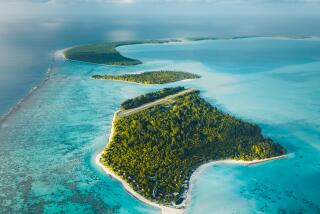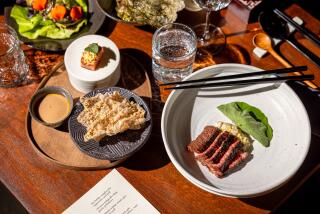Awash in Tropical Bliss on Bora-Bora
BORA-BORA, French Poly- nesia — BORA-BORA, French Polynesia--We felt like characters out of “Peter Pan” flying over a colorful kingdom, my son, Lachlan, and I agreed later. Arms spread like wings, holding hands, we were swept along with surprising force by the ostensibly tranquil teal waters of the tropical lagoon. Wide-eyed behind our snorkeling masks, we gazed at the coral gardens below.
Tugging at my arm, one of my 61/2-year-old twin boys pointed out wonders along the way: jutting branches of coral, resplendent in hues of royal blue, purple, lavender and dark yellow; broad, black patches of porcupine-like quills where sea urchins nestled together near hollows in the coral outcroppings; flashes of vivid colors and intriguing designs. Nor did the magic dissipate after our heads broke the surface. Deposited by the current on a motu, or islet, its white beaches thickly fringed by coconut palms, we walked around a point and were rewarded with a knockout view of Bora-Bora. This gem of a tropical island, the higher of its two volcanic peaks shrouded in mist, gleamed green against the pale waters of the lagoon. My own Bali Hai.
In fact, it was partly because I had heard that Bora-Bora was the inspiration for that song in the musical “South Pacific” that I heeded the island’s call. (I later learned it wasn’t, but never mind.) Conjuring up visions of tropical flowers in flowing black hair and bronzed bodies wrapped in bright fabrics--I have always been a devout “tropo-phile”--Bora-Bora became my dream destination.
Bora-Bora lies 165 miles northwest of Tahiti in French Polynesia’s Society Islands and is only about 20 miles in circumference. Its very name is provocatively primitive. Persuading my husband, Warren Lancaster, that we and our sons should have a real vacation on the way back from visiting his family in Australia, I booked us for eight days here last winter. I was determined that we would become beach creatures and, if possible, manage to slow down time itself.
We were not disappointed. Succumbing willingly to tropical torpor, we were happy to do little more than snorkel and take the shark-and-ray-feeding expedition that landed us on the motu. Bora-Bora is not for the easily bored, who might find more action on the larger Tahitian island of Moorea, but rather for those who have enough stimulation and stress back home, thank you. Had it not been for Lachlan and Cameron and their constant inquiries about what we would be doing next, we might have slowed time to a crawl.
Bora-Bora is enticingly exotic in a way that no place I have traveled to can replicate, including Hawaii. It’s impossible for me not to love a place where every restaurant has a thatched roof and an open-air veranda, and where even the soap smells of coconut and gardenia. On Bora-Bora, men as well as women wear flowers behind their ears--the left side signals that you’re taken, the right that you’re available--and pull their raven mane back from their face, weaving it with palm fronds and flowers.
Both sexes also sport pareus (PA-ray-ewz)--large rectangles of brightly colored fabric tied at the waist into a wraparound skirt--along with necklaces of shells and beads. It doesn’t take long for most visitors to aspire to this particular sartorial splendor.
Even with those multihued blue waters and green volcanic peaks, Bora-Bora could not be Bali Hai without the warmth of its people. We felt embraced and welcomed, never merely tolerated. When we and our children were without a place to eat one holiday night--the special dinner at our hotel, Le Maitai Polynesia, seemed prohibitively expensive--the host of the snack bar at a simple accommodation called Village Pauline made room for us in what already was a full house. We subsequently enjoyed a festive multinational barbecue that blended locals, American backpackers and French soldiers on leave.
When I was jogging one morning and distracted by a beachside clothesline pinned with pareus, the women selling them (for about $10 each) insisted I take the two I wanted even though I didn’t have enough cash with me. When I later returned with the money, they sent me off with an extra.
Our journey to Bora-Bora did not start out auspiciously. Low on cash, we arrived in Papeete, the capital of French Polynesia on the main island of Tahiti, and discovered that our bank cards, which worked fine in Australia and Europe, didn’t work at these ATMs. We foolishly hadn’t bothered with traveler’s checks, so we ended up charging money to our hotel bill, a luxury that came with a 5% commission. Island life was already costly enough: We tried to keep costs down by buying snacks and beverages at the island grocery stores.
Then there was our first night on Bora-Bora, spent about four miles south of the main town of Vaitape at a hotel on Matira Beach, where many of the island’s hotels and resorts are clustered. I awoke in the wee hours, sweating and swatting mosquitoes. To be fair, our bungalow was standard for the island in that it had no air-conditioning or screens on the louvered windows, only a pretty useless mosquito coil and an equally futile ceiling fan. And although most of our days on Bora-Bora were sunny, we were there in the warmer, muggier “wet season” between November and May, when mosquitoes can be a nocturnal nuisance. Our bungalow did not get the sea breezes, so I vowed to find a hotel with air-conditioning the next day.
Five minutes away by foot down the main road that circles the island, Le Maitai Polynesia was able to accommodate us. Like other upscale hotels on Bora-Bora, it offers breezy over-water bungalows but also has less expensive, more traditional accommodations across the road from the beach. Our room had a view of the sea and a sofa bed for our kids. At $231 a night it was more expensive than our first hotel, but mosquitoes had not figured in my tropical fantasies.
Although my mood improved dramatically, I soon wondered if somehow we had displeased the local deities. I arrived back at our first hotel to find that Lachlan had been bitten by a stray dog on the beach when he approached it and was screaming in my husband’s arms as they waited for a doctor. I held my son while the doctor stitched up wounds on both sides of his hand--at the same table in the hotel’s beachside restaurant where we had just eaten breakfast--and listened incredulously as the doctor reassured me that there was no rabies on the island. (Although the medical clinic and the police on Bora-Bora backed him up, I took no chances and had Lachlan start a series of vaccinations when we got home.)
A few hours later, Lachlan was showing off his bandages, and we were relaxing over salads and sandwiches at our new hotel’s beach restaurant while a stunning array of pareus displayed overhead swayed in the breeze. A couple of days later we saw an image that seemed even more quintessentially Bora-Boran. As we all swam around the patches of coral close to shore, I spied about a dozen bright red hibiscus blossoms bobbing in the bright blue waters, blowing in our direction. A local later told me that it was a tradition for people leaving the island to throw their crowns or necklaces of flowers into the lagoon. If the flowers made it to land, it meant that the person would return.
What was below the water, though, proved a constant fascination for us, especially the boys, whom I watched metamorphose into veritable amphibians. The highlight of the week was the day we spent offshore on the lagoon, with about a dozen other visitors of various nationalities, on a trip organized by Moanareva Tours and the hotel. Wearing fins or rubber reef sandals to protect our feet from the sharp coral, we rolled off the motorized outrigger canoe that was our transportation. Then, under the tutelage of Tepoe Pere, our principal guide, we gathered on one side of a rope barrier to watch as dozens of small, black-tipped reef sharks and manta rays congregated for a feeding.
Whereas the sharks were shy (and not dangerous), the rays were downright sociable. About 4 feet in wingspan with a tail of equal length, the gray-skinned creatures were silky and slippery to the touch. As long as no one made sudden movements that could alarm them, they would come up and rest their flaps on the shoulders of our guides, appearing to embrace them like long-lost friends, and take pieces of fish right from their mouths.
During the subsequent visit to the coral garden, we saw black-and-white zebra fish, pale, nearly translucent needlefish, brilliant blue damselfish and yellow, black and white angelfish. We lunched later on Motu Piti Aau (or as it is informally called, Motu Roa), “the long motu” across from Bora-Bora’s west side. Tepoe, swashbuckling as a pirate at the helm of our boat, emerged onshore to give a coconut-opening demonstration, dressed only in a hie oviri (a “wild crown” of tropical vines) and a shocking-pink-and-white pareu.
The coconut, its meat sliced and shared among us, was just an appetizer. On a pavilion under a thatched roof, laid out on palm fronds on one of several long tables, were plates of tuna and chicken barbecued by our guides, as well as bowls of rice and corn salad, baked bananas, raw tuna marinated in lime juice, and freshly cut slices of papaya and mango. This type of buffet, similar to the one we had enjoyed at Village Pauline, is easily the most satisfying kind of meal on Bora-Bora, never mind the generally pricey French cuisine that comes with the territory.
The multilingual Tepoe was a fount of information and local lore as well as a chef. Piloting the boat around the island, he pointed out Bora-Bora’s highest peak, Otemanu, 2,384 feet high, which reportedly has never been climbed because the stone of its sheer faces is too soft and crumbly. He showed us the rusted cannons protruding from the island’s hillside foliage, remnants of the days when more than 4,000 American troops were stationed here during World War II. When it was time to depart Bora-Bora a few days later, I created a crown of red hibiscus blooms, purple bougainvillea and some flamboyant red and yellow spiky flowers found by the road near our hotel. As the launch from Vaitape to the airport on Motu Mute motored past a beach, I braved a rare rain to go to the top level and gaze at the receding greenery. Lifting the floral crown from my head, I threw it in the lagoon, accompanying it with a little prayer that the flowers would float to terra firma and that we would see Bora-Bora’s shores again.
*
Debbie Seaman is a writer based in Connecticut.
More to Read
Sign up for The Wild
We’ll help you find the best places to hike, bike and run, as well as the perfect silent spots for meditation and yoga.
You may occasionally receive promotional content from the Los Angeles Times.






